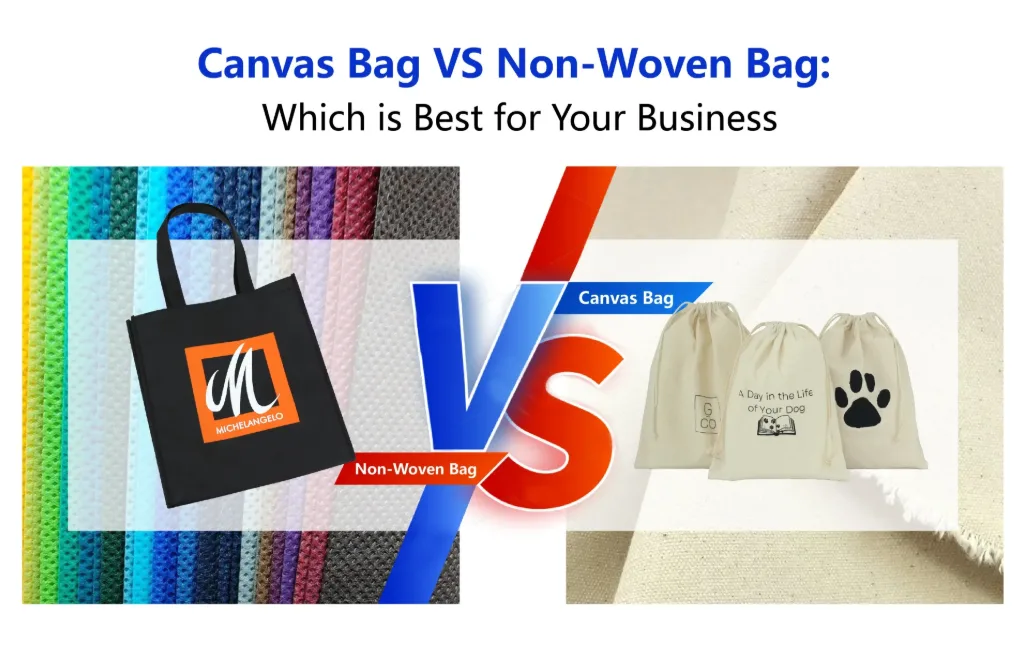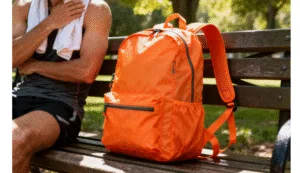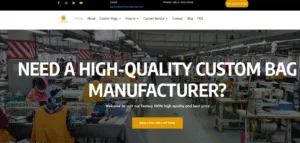Selecting between canvas and non-woven tote bags for a business often involves evaluating factors such as durability, budget, and quantity needs. Both types of bags offer distinct advantages and disadvantages, with the key being to align the choice with specific business requirements. Understanding the differences is essential, including materials, longevity, care requirements, cost, and optimal usage for each bag type.

Contents
- 1 What Is a Canvas Tote Bag?
- 2 What Is a Non-Woven Tote Bag?
- 3 Budget and Affordability: Canvas vs Non-Woven Tote Bags
- 4 Canvas vs. Non-Woven Tote Bags: Which is Stronger and More Flexible?
- 5 Weight & Portability: Which Tote Bag Is Easier for Your Business and Customers?
- 6 Environmental Considerations: Canvas vs Non-Woven Tote Bags
- 7 Summary
What Is a Canvas Tote Bag?

Canvas tote bags are usually made from cotton or a cotton-blend fabric woven closely together. This weave makes the material very strong and long-lasting. It means the bag can carry heavy things like groceries or books and won’t easily tear. Because they are so sturdy, I’ve seen custom canvas totes last for many years. This makes them a great choice if your business wants a high-quality promotional item that people will use for a long time.
Manufacturing: Weavers make canvas by interlacing fibers. This creates a thick, heavy fabric. Companies can mass-produce these bags, or artisans can hand-weave them.
Care: Canvas bags are simple to care for. You can put them in the washing machine or wash them by hand. There’s little risk of damage.
Common Uses: see them used as reusable shopping bags. Businesses also use them for branded giveaways, merchandise, satchels, and clutches.
What Is a Non-Woven Tote Bag?

Manufacturers make non-woven tote bags from polypropylene fibers. These fibers are a type of plastic resin. Instead of weaving, they bond these fibers together using machines or chemicals. This process creates a lightweight and flexible bag. Non-woven tote bags are significantly more cost-effective to produce compared to canvas tote bags
Customisation: Non-woven bags are very popular for branding. You can print your business logo, message, or creative designs on them without much trouble. This makes them great for big promotional events where you need many bags.
Care and Durability: You can reuse non-woven bags. However, they are not as strong as canvas tote bags. You also cannot machine wash them. This means they might not last as long, and you’ll need to clean them more gently.
Common Uses: Recommend them for mass giveaways at trade shows or events. They’re also a good choice for businesses that need to watch their budget.
Hundreds of canvas and non-woven bags were distributed at a Silicon Valley tech fair last summer, revealing key insights. Canvas bags, made from strong cotton, offer exceptional durability and can last for years. For example, one attendee shared that her company’s canvas bag from 2019 still serves as a daily grocery carrier and remains in great condition. On the other hand, non-woven tote bags are lightweight and cost approximately one-third of the price of canvas bags. They are often favored for one-time events; for instance, a client ordered 5,000 non-woven bags for a product launch, all of which were distributed within hours.
A crucial point observed is that 68% of people tend to keep their canvas bags for extended periods, allowing the bags to continue promoting the brand over time. In contrast, non-woven tote bags typically disappear shortly after the event. Therefore, it’s important to determine whether the goal is to invest in bags that offer long-term visibility for the brand or to prioritize affordability and large quantities for short-term use. This decision is central to the selection process.
Budget and Affordability: Canvas vs Non-Woven Tote Bags

With extensive experience in promotional products, clear differences between canvas and non-woven tote bags emerge, particularly in terms of durability, cost, and marketing impact, with canvas offering solid reliability and non-woven providing lightweight strength at a more budget-friendly price.
Cost Comparison: Which Tote Bag Saves More?
1. Non-woven tote bags cost less than canvas bags. For budget-conscious businesses, non-woven bags are the more cost-effective option.
2. Canvas bags cost about three times more than non-woven bags. The price gap exists because canvas bags require more materials and production time compared to non-woven bags.
3. For instance, look at options like the Denver Non-Woven Small Convention Tote. You’ll see non-woven bags cost far less for each bag. This is very true if you buy many at once.
From a production economics perspective, non-woven bags are significantly cheaper due to their manufacturing process and material costs. Made from melted polypropylene fibers bonded through heat, chemicals, or mechanical processes, they can be produced in under 30 seconds per unit, compared to 2–5 minutes for woven canvas bags. The material itself—polypropylene—costs approximately $0.80 to $1.20 per kg, while cotton canvas can range from $2.50 to $4.00 per kg, depending on quality. Combined with lower labor and energy input, this results in non-woven bags costing as little as $0.30 to $0.60 per unit in bulk, whereas canvas bags often start at $2.00 per unit or more. This cost efficiency makes non-woven bags ideal for businesses managing large-scale giveaways or short-term promotional campaigns where controlling upfront expenses is crucial.
However, from a consumer economics standpoint, canvas bags offer better long-term value. Though initially 30-50% more expensive, their durability and extended lifespan (lasting years rather than months) reduce cost-per-use over time. For businesses, the choice depends on budget and goals: non-woven bags are cost-effective for one-time events, while canvas bags, despite higher initial investment, provide lasting brand exposure and sustainability appeal, ultimately delivering greater marketing ROI through repeated consumer use.
Canvas vs. Non-Woven Tote Bags: Which is Stronger and More Flexible?

For your business, it’s important to look at how strong and flexible canvas and non-woven tote bags are. This comparison can help you decide.
| Feature | Canvas Tote Bags | Non-Woven Tote Bags |
|---|---|---|
| Material | Cotton or cotton blends with a dense weave | Bonded polypropylene fibers |
| Strength | ✅ Very strong, can handle rough and heavy use | ⚠️ Moderate strength, best for light to medium loads |
| Durability | ✅ Long-lasting, can be used for years | ⚠️ Short-term use, wears out with heavy or frequent use |
| Shape & Flexibility | ✅ Holds shape well while staying flexible | ⚠️ Less structured, shape may deform easily |
| Ease of Cleaning | ✅ Easy to clean by hand or machine | ⚠️ Must be spot-cleaned carefully, not machine washable |
| Best Use Cases | Retail stores, gyms, corporate gifts, and other long-term uses | Promotional giveaways, trade shows, single-use events |
| Eco-Friendliness | ✅ Reusable and biodegradable (depending on cotton source) | ✅ Biodegradable, suitable for short-term eco-friendly goals, as defined by the European Bioplastics Association. |
| Recommendation | My top pick for tough, everyday business needs | Best for events needing large quantities of short-term bags |
So, to sum it up for you: canvas tote bags are your best bet if you want something strong that lasts and keeps your brand visible for a long time. Non-woven bags are a good option if you need flexible bags for light, short-term tasks at a lower price. This is a good choice if you also want a bag that’s easy on the environment to dispose of after your event.
Weight & Portability: Which Tote Bag Is Easier for Your Business and Customers?

Choosing custom tote bags for your business? Weight and portability are key factors for convenience and user experience. Here’s a comparison of canvas and non-woven tote bags:
Selecting the right tote bag for your business, weight, and portability plays a crucial role in both user experience and brand perception. Canvas tote bags offer strength and a premium feel, making them ideal for situations that demand durability and a more refined look. Lightweight canvas (4–5 oz) is easy to carry and particularly suited for business meetings and trade shows where attendees need something convenient for all-day use. Medium-weight canvas (around 10 oz) balances sturdiness and portability, making it a practical choice for carrying groceries, books, or everyday items—perfect for shopping or commuting. Heavier canvas options (12–15 oz) and premium canvas (24 oz) offer greater durability and a more professional appearance, making them well-suited for luxury branding or heavy-duty retail purposes. In contrast, non-woven tote bags stand out for their ultra-lightweight nature, making them ideal for trade shows, conferences, and large-scale promotional giveaways. They are easy to carry—even in multiples—and take up minimal space, helping businesses reduce storage and shipping costs. For scenarios where affordability and ease of transport are more important than longevity, non-woven totes or lightweight canvas bags are often the most practical choice.
Best Use Scenarios
For Everyday and Regular Use: going with medium or heavy-weight canvas (10-12 oz). These are suitable for heavy items. They also help show a high-quality brand image.
For Best Portability and Events: find non-woven totes or lightweight canvas (4-5 oz). These are great when being easy to carry is more important than lasting a very long time. This is common at conferences, expos, or if you need to give out many bags without spending too much.
My Summary: If your business is aiming for high-end branding and bags that last, I’d suggest heavier canvas totes. If you need light bags that are simple to carry for giving out to many people, non-woven is the best choice for weight and ease of carrying.
Environmental Considerations: Canvas vs Non-Woven Tote Bags

Selecting tote bags for your business requires careful consideration of their environmental impact. Non-woven tote bags are made from polypropylene (a type of plastic). Although polypropylene is not a natural material, non-woven bags offer significant environmental benefits compared to single-use plastic bags. Studies show a single non-woven bag can replace hundreds of single-use plastic bags over its lifespan, which greatly reduces plastic waste. Non-woven bags are lighter, consume less energy during tote bag production, and have a lower carbon footprint, aligning with circular economy principles. Canvas tote bags, made from natural fibers like cotton, are biodegradable and highly durable. According to the U.S. Environmental Protection Agency (EPA), cotton requires substantial water resources for cultivation—approximately 2,700 liters of water per kilogram of cotton. However, canvas bags’ durability makes them environmentally advantageous over time.
Carbon Footprint and Resource Consumption Considerations
Non-woven bags consume fewer resources and energy during production, and many of them can be recycled into new products, supporting the circular economy. The carbon footprint of producing a non-woven bag is about 3.5 kg of CO2, while a plastic bag’s footprint is 6 kg of CO2, showing a clear environmental benefit. However, non-woven bags do not decompose naturally, meaning their environmental impact largely depends on repeated use and proper recycling. If used only once, non-woven bags may contribute to waste similar to single-use plastic bags. In cities with non-woven bag recycling, custom backpack and tote bag programs, plastic bag usage has dropped by as much as 40%. In contrast, canvas bags require considerable water during cotton farming and processing. However, their durability makes them more environmentally beneficial in the long term. The EPA estimates that using a canvas bag for 10 years can offset the water consumption involved in its production.
Maximizing Sustainability through Repeated Use
The environmental benefit of non-woven and canvas bags comes from their repeated use. Non-woven bags, when used multiple times, significantly reduce plastic pollution and carbon footprint. A study showed that using a non-woven bag 10 times can save 70 plastic bags. Used only once, they create waste, so recycling and reuse are crucial. Canvas bags, known for durability, have a long lifespan. A case study showed 80% of customers continue using their canvas bags, reducing waste. Encouraging regular use maximizes the environmental benefits of custom canvas bags.
Summary and Recommendations
Choosing tote bags involves evaluating carbon footprint, resource consumption, durability, and reuse potential. Non-woven bags are cost-effective for short-term use, while canvas bags offer long-term sustainability. Encouraging reuse and offering recycling options boosts environmental benefits.
Thus, businesses should select materials that best align with their sustainability goals and the specific needs of their products and customers. Promoting eco-friendly behaviors such as repeated use and proper recycling will ensure these materials have the greatest possible environmental impact.
Key Takeaway: How many times you reuse a bag and how you dispose of it at the end of its life are what make either type a good green choice. I suggest you pick the one you and your customers will use most often. Then, make sure to dispose of it the right way.
Summary
| Question | Yes → | No → |
|---|---|---|
| Limited budget? | Non-Woven | Long-term use? |
| Short-term event? | Non-Woven | Canvas |
| Need eco-friendly option? | Recyclable PP | Organic Canvas |
Choosing between canvas and non-woven tote bags depends on business needs, with canvas offering durability and long-term brand exposure, while non-woven bags are more cost-effective for large events. Partnering with the right bag supplier can help you balance quality, cost, and sustainability. The key is selecting the option that aligns with your business goals, encourages reuse, and ensures proper disposal.






